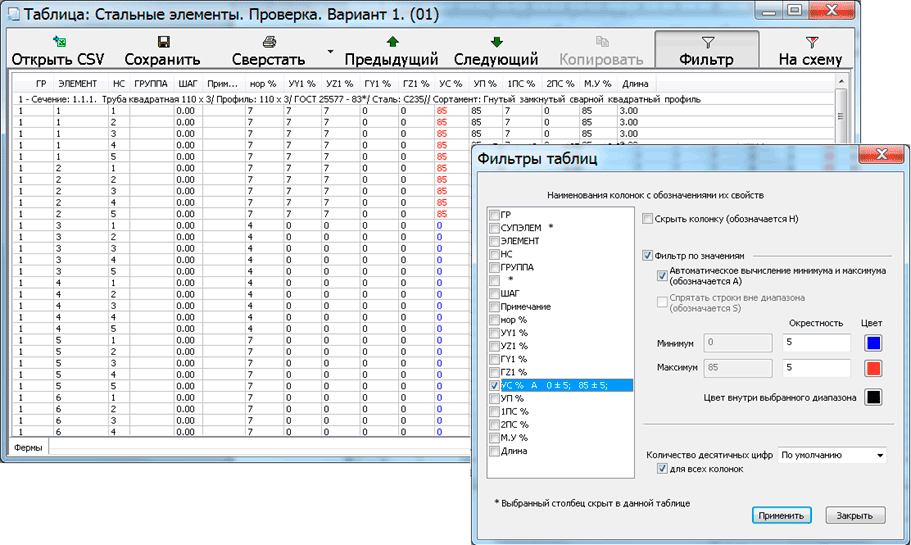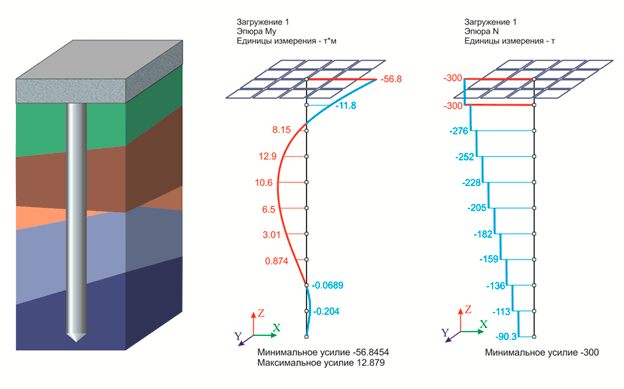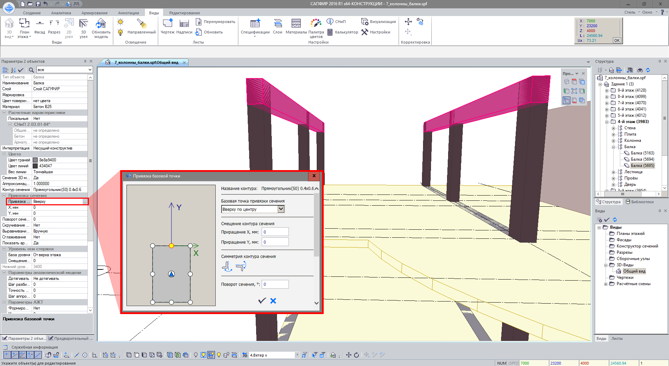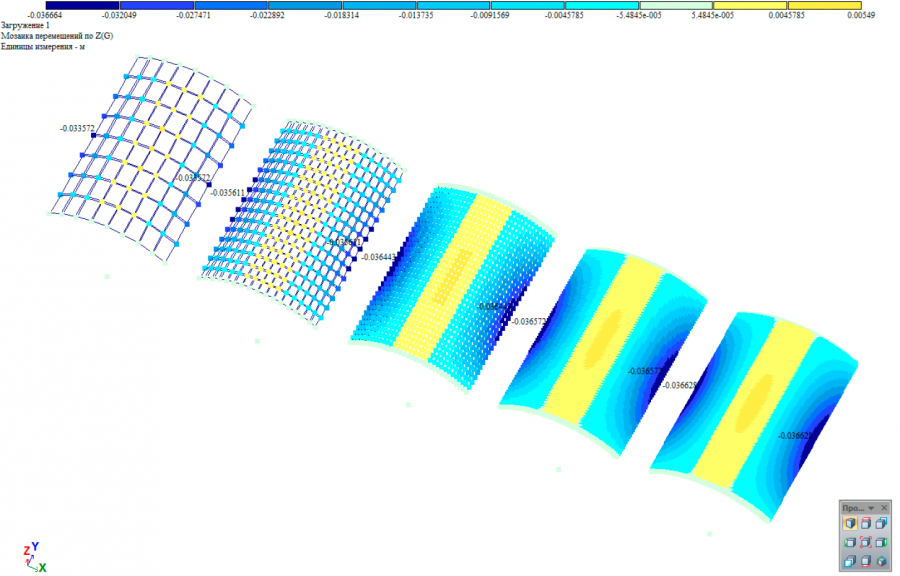New release LIRA-FEM R2 is presented on July, 27. Demo version of LIRA-FEM version 2016 is also presented.
New Demo version LIRA-SAPR 2016 provides you with access to all elements of user interface, you could get familiar with all modes of the program, generate (with no serious limitations) design models for buildings and structures of various purpose. But options to save and analyse the model are available only for problems that are not beyond limitations imposed on demo version (design model should contain not more than 1000 nodes and 1000 elements).
New features and options in LIRA-SAPR 2016 R2
• Added option: import of design models from Revit Structure 2017.
• Added option: compatibility between KM-SAPR 2016 module and AutoCAD 2017.
• Clarified option: priorities for group selection of nodes and elements on the model when you apply construction lines and levels in order to select items with ‘selection window’.
• Added option: to save current settings for reinforcement colour palette in the modes of discrete values and uniform numerical values of colour palette.
• Modified option: to present dialog boxes outside the working window of the program when the dual screen mode is used.
• Enhanced option: to edit and visualize surface loads on solids.
• Clarified data about surface loads imported from SAPFIR-Structures module.
• Clarified option: to generate and visualize mosaic plots of heat loads on plates.
• Enhanced option: to generate diagrams of output data along arbitrary section in plates, diagrams are updated automatically when mosaic/contour plots of output data are changed.
• Fixed minor error: when preview analysis results for DCF calculation for super-elements problems.
• Enhanced option: to visualize analysis results for load on fragment by design combinations of loads (DCL); to visualize min and max values of displacements and loads on fragment by DCL for cases when number of specified DCL exceeds number of load cases.
• Restored option: to generate the DCL table (at initial stage) according to data about load cases defined previously for the DCF table.
• Restored option: to carry out stability analysis by separate forces if the DCL table is not defined.
• Enhanced option: to import projects from MONOMAKH-SAPR program to LIRA-FEM through ÒÕÒ-format for description of design model.
• Enhanced option: to visualize the analysis results for reinforcement in bars (symmetric reinforcement, asymmetric reinforcement, circular reinforcement).
• Clarified option: to visualize mosaic plots for transverse reinforcement in plates when the values are visualized per 1 m2.
• Enhanced set of parameters that should be defined for documentation templates in order to automatically generate graphic and tabular documentation for all (or selected) load cases, design options, DCL, DCF, mode shapes, buckling modes, etc.
• Added option: account of specific/emergency loads in DCF analysis for punching shear contours.
• Fixed bug: when slenderness ratio for elements of trusses is calculated by SP 16.13330.2011.
• Corrected option: filter by RC materials.
• Fixed bug: when defining materials for RC.
• Fixed bug: when generate drawings exported from BEAM and COLUMN systems.
• Modified option: tables of analysis results (defined for selected nodes) for punching shear contours by DCL.
• Modified option: to import design models from STARK ES through SLI-format.
• Updated Help system: Report Book options are described in detail.
A number of other minor inaccuracies are corrected.
SAPFIR-Structures
• Properties of previously selected object for piles may be inherited; mirror copy and rotation options for single piles are available.
• Generation of load across the area from the library objects is enhanced.
• Several loads that belong to the same or different load cases may be united into block. When visualization filter is set for load cases, then loads included into block will be presented according to active load case.
• Modified option: to save linear loads and surface loads (generated with the Loads tool) to s2l format.
• Added option: check of the DCL table contents when exporting to VISOR-SAPR for examples when load cases were added after generation of DCL table.
• Enhanced snap to objects of dxf background. Snap to intersections of lines located within the same layer.
• Added option: for plate elements (wall, slab, surface), it is possible to present analytical model in colour of material.
• Added option: to edit properties, in particular properties of analytical model (loads and boundary conditions), for the group of stairs of the same type.
• Fixed bug: search for intersections between elements used for a snap and new elements (for the ‘Generate fragment in SAPFIR’ command in LIRA-FEM program).
• Mirror copy option is available for grid lines.
• Enhanced work in the ‘Grid lines’ dialog box.
Design of RC structures
• Enhanced options in the ‘Dowels’ mode:
- to generate dowels for columns with asymmetric snap of section contour relative to base point of the column;
- to save the specified length and direction of hooks when you change method of displacement for dowels relative to vertical rebars;
- to edit nodes of dowels in groups.
• Added option: to put notation for elevation marks on patterns of reinforcement for columns, walls and beams.
• Enhanced option: to divide zone of reinforcement in wall into two. When you move the pointer, division line is presented automatically. The program checks wether division line is located within the working area of reinforcement.

• Enhanced option: ‘Rebars’ command on the reinforcement pattern for wall.
• Added option: check whether columns interpreted as loads are not present in the list when you create unification groups.
• Fixed bug: presentation of spacers (OSp1) in specification of reinforcement for slab on the sheet of drawing.
• Added option: to conveniently and easily change the building code for the rolled sheet and class of technological reinforcement applied for spacers.
• Modified option: for views with option ‘View for results’, method for displaying notations included into block.
New program version is available - LIRA-SAPR 2016.
Integration with other software products – realization of BIM technology
SAPFIR analytical model may be exported to STARK-ES positional model that contains data about element type (wall, column, beam, slab), storey that the element belongs to, model geometry, materials, stiffness parameters and loads.

New technology ‘Tekla Structures — LIRA-FEM — Tekla Structures’ is introduced. It allows the user to generate the model in Tekla Structures, then import it to LIRA-SAPR, carry out static and dynamic analyses, select sections of elements and reinforcement, export analysis results to Tekla Structures and further obtain detail drawings (for reference, in Russian - drawings KMD) and CNC.

For detailed description, see the following link: Integration: Tekla Structures — LIRA-SAPR
Unified graphical user interface (GUI)
New option to work with several tables of DCF and DCL within the same problem. The user is provided with the simple and convenient tool to carry out multi-variant analyses and comparative evaluation of analysis results obtained for different building codes (traditional SNIP and updated SP), by varying logics to consider accompanying and mutual exclusion of load cases, applying different sets of combination coefficients. There are also more ways to generate design options. The user could select appropriate DCF or DCL table for certain design option and define different material properties as well.
Options of graphical visualization of analysis results are dramatically enhanced.
- For displacements and forces, it is possible to preview extreme (min and max) values selected from all defined load cases or DCL. Obtained envelope lones are presented as diagrams and mosaic plots.
- Graphical presentation of analysis results for DCF calculation. Design and normative DCF (complete and live) are presented on the model as mosaic plots and envelope diagrams of extreme values.
- For analysis of RC structures with ‘NL Engineering’ system, it is possible to generate mosaic plots of integral stiffness parameters for bars and plates.
No limitations on possible number of specified load cases as it was in previous versions (not more than 96 load cases when DCF and METEOR systems are used, otherwise not more than 300 load cases). These limitations are removed for all types of analyses.
New option to compute rigidity centre and centre of gravity for the fragment (storey). The user could quickly and visually evaluate potential for torsional vibrations in dynamic (earthquake) loads and modify arrangement of design model, if required.
More options to select objects on design model. Now the user could select nodes and elements by clicking (or dragging ‘selection window’ across) appropriate ranges on colour palette, construction lines and levels.
Information presented in the dialog boxes about selected node/element is considerably updated and expanded. In the mode of analysis results, it is possible to evaluate information about displacements or forces obtained in any of computed DCF and/or DCL tables.
New option to compute deflections for bars and plates relative to node with zero relative displacement (specified by the user on the model). Diagram of deflections is presented in a separate window and may be saved to the Report Book.
No limitations on number of nodes when you generate perfectly rigid bodies (PRB). In previous versions, one PRB could include not more than 200 nodes.
New ‘Characteristic DCL’ method. It enables the user to considerably reduce time during check and selection of reinforcement and steel sections. The efficiency of this method is observed with increase in number of specified DCL. If number of DCL is more than 100, time of analysis is reduced in 10 or more times.
New technology for defining materials for RC structures. When you define new parameters, it is possible to preview and evaluate all previously defined data for concrete, reinforcement and design requirements. There is common interface to define material properties in VIZOR-SAPR and SAPFIR-Structures modules.
Enhanced technology for generation and editing surface loads. Data connection between parameters of surface loads and parameters of appropriate groups of concentrated loads. The name is assigned to every surface load. This name may be modified later. It is possible to preview surface loads and modify its intensity. When you visualize mosaic plots of distributed loads, surface loads are presented with values of its intensity.
Documentation is generated in less time due to templates.
New tools for presentation of analysis results in tabular form.
Drag and drop functionality is used to organize elements in the Report Book.
All new features and enhanced modes of the program are presented in the updated ribbon and standard interfaces and have context-sensitive help.
Document system: Report Book

For detailed description, see the following link: LIRA-SAPR 2016 - Report Book: new features and options
FEA-solver
Speedup factorization (decomposition) in matrix of system equations. Acceleration in 8 times is observed in tested problems.
Static and dynamic analyses with account of change in stiffness values for bar and plate finite elements. This change relates to the axial force in bars and membrane group of forces in plates.
Enhanced procedure for generation of consistent mass matrix.
Account of PRB is enhanced in dynamic analysis.
Enhanced analysis of structures that include bars and plates with one-way subgrade moduli.
DBN B.1.1 — 12:2014 'Construction in seismic areas' is supported.
No limitations on number of load cases.
No limitations on number of loads in perfectly rigid body (PRB).
Analysis of reinforced concrete (RC) structures
In plate elements, it is possible to analyse reinforcement using different concrete covers for differently directed reinforcement.
For plate elements in compression (wall, diaphragm), reinforcement may be analysed with account of slenderness in vertical elements (effective lengths are defined in the similar way as for bar elements in ‘Materials’ section).
Analysis of steel structures
SOIL
New option to simulate pile with the chain of vertical bars. Vertical and horizontal stiffness of soil are simulated with finite elements located at nodes of this chain. The stiffness values are computed automatically according to properties of 3D soil model. Then you will be able to obtain diagrams of forces N, My, Mz, Qy, Qz along the whole length of pile and analyse reinforcement in pile. Upper bar in the chain – pile head – may simulate hinge or rigid support of foundation slab on pile.
The program takes into account mutual integration of piles according to method presented in the ‘Analysis of settlement of pile bunch’ chapter, sect. 7.4.4, 7.4.5 SP 24.13330.2011 'Pile foundations'.
The program automatically generates FEs that are located along the edges of the specified soil model and simulate the soil beyond its limit. Stiffness of finite elements is calculated automatically according to adjacent layers of the generated soil model.

For detailed description, see the following link: Simulation of pile with the chain of vertical elements
*/?>
METEOR
Enhanced options in METEOR system. With integrated problems, you could design not only by DCF but by characteristic DCL as well.
SAPFIR-Structures
In material properties of SAPFIR, there is new option to assign design parameters that will be considered as input data for analysis of reinforcement in VISOR-SAPR module. These parameters are assigned automatically to structural elements according to material properties. Later the user could modify design parameters for every structural element separately.

New ‘Load cases’ dialog box that includes Load case editor, tables of input data for DCL and DCF. On the ‘Edit load cases’ tab the user could generate a set of load cases, assign the type and subtype of safety factors, duraction factor, mutual exclusion, unification, accompanying and sign variability. Data from the ‘Edit load cases’ tab is used to automatically generate combinations of loads (DCL and DCF). DCL and DCF tables are generated according to building codes SP 20.13330.2011, DBN B.1.2 - 2:2006, SNIP 2.01.07 -85*. All combinations are generated based on the data from the ‘Rules for combinations’ dialog box that contains a set of coefficients and formulas to generate both normative and user-defined combinations. Above-mentioned parameters may be saved to file and used in other projects.
New tool to define earthquake load according to the following building codes: SP 14.13330.2014, DBN B.1.1-12:2006 and SNIP II-7-81*. All parameters for the earthquake load are defined in the same dialog box:
- direction of earthquake load;
- units of magnitude;
- soil category;
- number of mode shapes;
- type of structure;
- all appropriate coefficients of the building code in use;
- load cases that generate masses for earthquake analysis.
These parameters are used in earthquake analysis in VISOR-SAPR module and no additional data is required.
The user could define several earthquake load cases in different directions.
Detailed analytical model of the stairs may be generated. Stairs from RC are simulated with plates while stairs with saddles and strings are simulated with bars of the specified section. Dead and live loads may be defined to the load-bearing elements of stairs. It is also possible to define boundary conditions at places where these elements intersect the framework of a building.
Additional lines and points of triangulation for slabs may be defined and modified at the stage of model generation.
New object ‘Pile’ is presented: vertical bar of the specified cross-section; its stiffness is defined as bearing capacity and settlement. It is possible to arrange either single piles or pile groups in an ordinary or staggered type – along the line (strip) or inside arbitrary contour. Parameters for the pile group (e.g. step, number, contour line, etc.) may be modified. Location of piles is taken into account during triangulation of foundation slab in design model. When piles are transferred to VISOR-SAPR module, appropriate FE type is assigned to them.

Option to save *.spf file for previous versions of SAPFIR program: SAPFIR 2015, 2014 and 2013.
Enhanced functionality for the ‘Grid lines’ tool. The user could define arbitrary name for the line in the grid, automatically modify dimension of mark in case of long name. With the ‘Explode block’ command, grid of lines may be transformed to the set of single lines.
Grid lines may be visualized at the level of active storey. In parameters for line it is possible to define the storeys where the line should be visualized.
For columns and beams, snap point of the section may be chosen graphically.
Enhanced diagnostic functions for the generated model. The user could choose appropriate check criteria for certain objects.
More options for detailed design documentation: list of sheets is generated automatically, documents may be printed to non-standard format, sequence of sheets in a set may be defined, renumbering of sheets, automatic links to joints according to actual numbers of sheets.
Modified dialog boxes where you could show/hide and select elements. They include only types of elements available in the active view.
Enhanced tools to edit the model:
- to make fillet and chamfer of the specified radius for defined corners in selected object;
- to dynamically display the box where the user could input distance up to the next vertix from the previously defined one;
- to move common vertix that belongs to several objects;
- to select several segments in the slab and assign common properties for support, etc.;
- to move the vertix of selected object without the need to activate appropriate command.

Design of RC structures
New program mode ‘Dowels’. For foundation slabs, pattern of dowels for vertical elements (columns and diaphragms) may be generated on the basis of concepts developed at the stage of design of these elements (in Design of RC structures Column, Design of RC structures Diaphragm modules) that are supported on foundation slab. Specifications for reinforcement dowels are presented, drawings of joints and their location on plan of foundation slab are generated.
Cross-section of reinforcement in slab may be presented with notations for location of rebars of main and additional reinforcement, technological reinforcement and (for foundation slabs) dowels to vertical elelements (columns, diaphragms).
New tool to unify reinforcement in slabs. This tool enables the user to evaluate and compare analysis results for reinforcement in identical slabs in order to find out slabs with similar reinforcement pattern and unite them into unification groups. When unification groups are generated, superposed contour lines for area of reinforcement in several selected slabs may be visualized simultaneously. Numerical values are presented in the table. The common mark is assigned to slabs in the same group. To design the prototype of unification model, the envelope line with analysis results for reinforcement is generated. It displays max values for area of reinforcement obtained in analysis of all samples of slabs with this mark.







